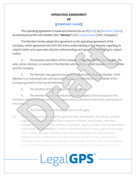Understanding Indemnity Agreements: A Must-Read Guide for Businesses
As a business owner, you want to feel secure in your operations and protected from unexpected challenges or hazards. One vital tool that helps manage...
6 min read
LegalGPS : July 24, 2024 at 1:40 PM
Navigating the world of business transactions can be a daunting task, especially when it comes to understanding the ins and outs of escrow agreements, earnest money deposits, and letters of intent (LOI). In this comprehensive guide, we'll break down and explain these complex concepts, helping you make informed decisions that best suit your needs. Remember, every successful business transaction begins with a solid understanding of the fundamentals.

Legal GPS templates are drafted by top startup attorneys and fully customizable.
Entering a business transaction often involves a great deal of negotiation and planning. Escrow agreements, earnest money deposits, and LOIs play vital roles in this process. Each of these components serves to build trust between parties and provide a solid foundation for a successful transaction.

An escrow agreement is a legal document that outlines how certain assets (such as funds, securities, or real estate) will be held and managed by a neutral third party—referred to as the escrow agent—until the conditions of a separate agreement between the involved parties are met. Essentially, it's a contractual arrangement that guarantees the security and proper transfer of assets involved in a business transaction.
Escrow agreements are important for various reasons:
They provide security for both parties in the transaction by ensuring that funds or assets are not released unless all agreed-upon conditions are met.
They establish an impartial third party (the escrow agent) to handle the assets, reducing the risk of fraud or mismanagement.
They can help to prevent disputes between parties, as the escrow agent ensures that the terms of the agreement are fulfilled before releasing the assets.
They help to ensure that the transaction goes as planned, which can reduce the chance of financial loss or legal disputes.
They can help to reduce the risk of fraud or mismanagement.
They provide an impartial third party (the escrow agent) to handle the assets, reducing the risk of fraud or mismanagement.
They can help to prevent disputes between parties, as the escrow agent ensures that the terms of the agreement are fulfilled before releasing

Protect your business with our complete legal subscription service, designed by top startup attorneys.
An earnest money deposit (EMD) is a sum of money paid by the buyer to demonstrate their commitment to a transaction, such as the purchase of a property or business. The EMD is typically held in escrow until the transaction closes, at which point it becomes part of the down payment. If the buyer backs out of the transaction without a valid reason (as outlined in the contract), they may lose their EMD.
Example: Bob and Jane are buying a house together. They submit an offer to purchase the home for $100,000. The seller agrees to the price, but wants $5,000 in earnest money deposit to ensure that Bob and Jane will follow through on their commitment.
A letter of intent (LOI) is a non-binding document that outlines the terms of a potential agreement between two or more parties. Although not legally binding, LOIs serve as a valuable tool for negotiating and finalizing the terms of a contract. They provide a roadmap for the negotiation process and establish a framework for drafting the final agreement.
Example: Bob and Jane are house-hunting. They find the perfect home that they want to purchase, but before they make an offer, they speak with their real estate agent. The agent tells them that it’s customary for buyers to sign a letter of intent prior to submitting an offer on a property.
In many cases, an escrow agreement will be used in conjunction with an EMD and LOI to secure a business transaction. Here's how they fit together:
The buyer and seller express mutual interest in entering a transaction and begin negotiations.
The parties may draft an LOI to outline essential terms and outline their intentions.
Upon further agreement, the buyer submits an EMD as a show of good faith and commitment to the transaction.
The parties establish an escrow agreement to hold the EMD securely, with instructions for its release upon the fulfillment of certain conditions or contingencies.
Once all conditions are met, the earnest money is either applied to the purchase price or returned to the buyer, and the transaction can proceed to closing.
Start by selecting a reputable, trustworthy escrow agent. This can be an attorney, bank, or title company with experience in managing assets and overseeing transactions. Reach out to your network for recommendations, or research online to find an agent well-suited for your needs.
Clearly define the assets to be held in escrow, such as funds, property or securities. Provide a detailed description, including the value, current owner, and any restrictions or conditions. Include supporting documentation, such as property deeds or stock certificates, to ensure the escrow agent has a comprehensive understanding of the assets.
Clearly set the conditions that must be met before the escrow agent can release the assets. These may include deadlines for inspection, due diligence or financing approval, as well as contingencies like obtaining necessary permits or addressing specific concerns raised during the pre-purchase investigation.
Begin by writing the introductory section of the agreement, which should include the names of the buyer, seller, and escrow agent, as well as the date and purpose of the agreement. Next, outline the responsibilities of each party:
Escrow agent: Detail the specific duties of the escrow agent, such as holding the assets, verifying fulfillment of conditions, and releasing the assets as required. Also, mention any required reporting or communication with the parties.
Buyer: Define the buyer's obligations, which may include depositing the earnest money, securing financing, and adhering to the agreed-upon timelines.
Seller: Establish the seller's responsibilities, such as providing necessary documentation, cooperating with inspections or appraisals, and correcting any issues discovered during due diligence.
Establish the process for releasing the assets from escrow once the specified conditions have been met. Detail what documentation or approvals are required and whether all parties must be present to sign off on the release. Additionally, outline a process for handling disputes that may arise during this stage.
Clearly outline the escrow agent's payment structure, including any fees, commissions, or expenses they may charge. Specify whether the buyer, seller, or both parties are responsible for these costs and when payment is due.
Review the agreement carefully to ensure that all terms and conditions are accurate and comprehensive. Double-check to confirm you've included every necessary element. Once satisfied, all parties—buyer, seller, and escrow agent—should sign and date the escrow agreement to make it legally binding.
After executing the agreement, make sure each party receives a copy for their records. Having a copy readily accessible ensures all parties understand their responsibilities and can refer to the agreement if questions or disputes arise.
By following these steps, you can confidently create an escrow agreement that addresses the needs and expectations of all parties involved. Remember, the more detailed and specific your agreement, the better chance you have of avoiding misunderstandings and fostering a successful transaction.
Get Your Escrow Agreement Template
with a Legal GPS Subscription
There are three main parties involved in an escrow agreement:
Buyer: The party that initiates the purchase and provides the assets (such as funds) to be held in escrow.
Seller: The party that agrees to sell goods or services and will receive the assets once the transaction is complete.
Escrow Agent: The neutral third party that holds and manages the assets in escrow, ensuring the agreed-upon conditions are met before their release.
To ensure a smooth and secure transaction, consider the following precautions when drafting an escrow agreement:
Verify the credentials and reputation of the escrow agent, ensuring they're capable of handling the scope and complexity of the transaction.
Communicate openly and honestly with all parties involved, addressing any concerns and discussing potential scenarios for dispute resolution.
Carefully outline the terms and conditions of the agreement, specifying key milestones or contingencies to minimize the risk of misunderstandings.
Consult with legal counsel to ensure the agreement complies with all applicable laws and regulations.
Now that you have a solid understanding of escrow agreements, EMDs, and LOIs, you're well-equipped to forge ahead with your business transactions. Drafting these agreements can be complex, but our professionally designed contract templates can save you time, money, and potential legal headaches.
Our team of legal experts handcrafts our templates to ensure they're comprehensive, user-friendly, and up-to-date with current laws and regulations. When you choose a contract template from our ever-expanding library, you're taking the first step toward a secure and successful business transaction. Check out our Escrow Agreement template if you're still unsure about the next steps!
Get Legal GPS's Escrow Agreement Template Now

Protect your business with our complete legal subscription service, designed by top startup attorneys.

As a business owner, you want to feel secure in your operations and protected from unexpected challenges or hazards. One vital tool that helps manage...

When it comes to commercial leasing, there's a lot to consider for the everyday entrepreneur. One option that stands out among the rest is the Buyer...

Have you ever heard of the term "assumption agreement" and wondered what it meant? You're not alone. To understand assumption agreements, we need to...